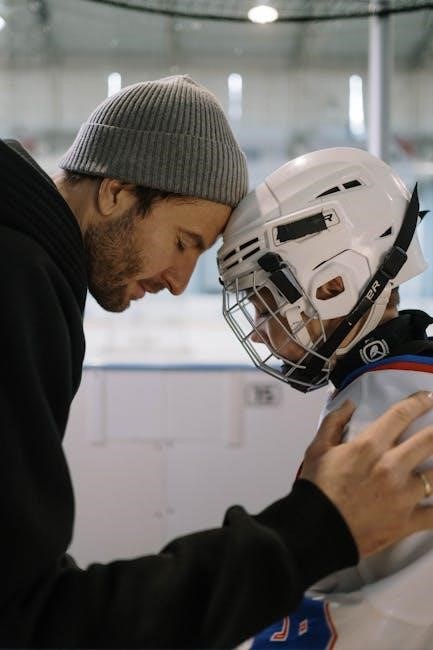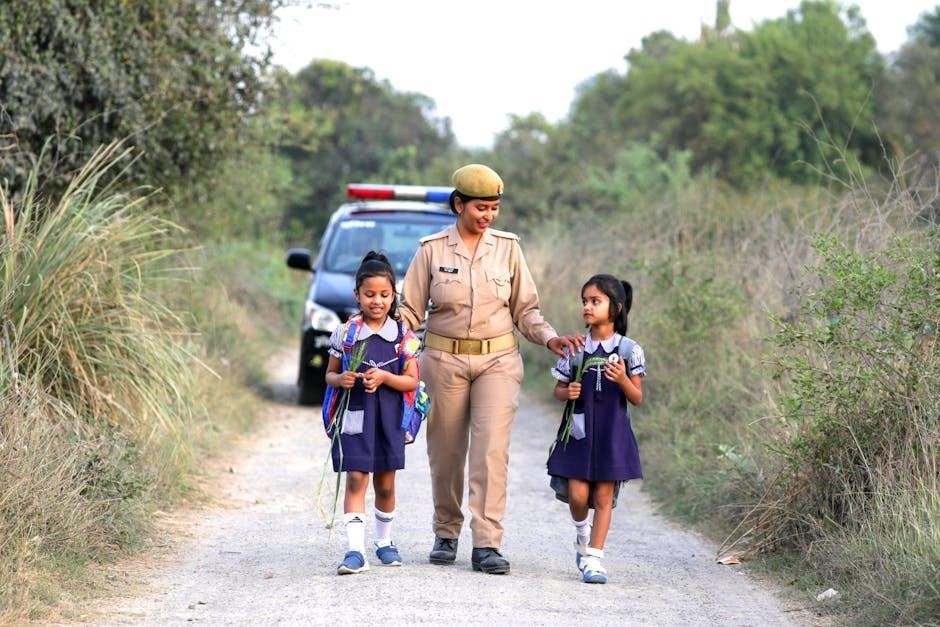The AFJROTC Uniform Guide outlines four primary uniforms: Class A, Class B, ACU, and PT. Proper wear includes centered name tags, ribbon racks, and adherence to grooming standards. Uniforms must be neat, clean, and reflect military image.

The AFJROTC uniform is a symbol of professionalism, discipline, and pride for cadets. It reflects the standards of the U.S. Air Force and is worn to promote unity, respect, and a military image. Cadets are expected to maintain high standards of appearance, ensuring their uniforms are clean, well-fitted, and properly accessorized. The uniform guide provides detailed instructions on how to wear each component correctly, from the placement of insignia and ribbons to the grooming standards that must be upheld. Proper wear of the uniform is not only a matter of personal pride but also a representation of the AFJROTC program and its values. Cadets are required to adhere to these guidelines whenever they don the uniform, whether during weekly wear, special events, or competitions. By following the uniform guide, cadets demonstrate their commitment to the principles of the Air Force and the AFJROTC program.

Types of AFJROTC Uniforms

The AFJROTC program utilizes four distinct uniforms, each designated for specific occasions and activities. The Class A uniform is the most formal, typically consisting of a blue shirt, tie for males, and appropriate attire for females, worn during inspections and official events. The Class B uniform is less formal, often omitting the tie, and is suitable for daily activities. The ACU, or Airman Combat Uniform, is a camouflage uniform used for field training and exercises, designed for durability and practicality in outdoor settings. Lastly, the PT uniform is worn during physical training, emphasizing comfort and mobility for workouts and exercises. Each uniform serves a unique purpose, reflecting the cadets’ adaptability and professionalism in various contexts;
Class A Uniform Details
The AFJROTC Class A uniform is the most formal attire, reflecting professionalism and adherence to strict standards. For males, it includes a dark blue shirt with a centered name tag on the right pocket and ribbons on the left, arranged from right to left by precedence. Females wear a similar shirt with appropriate neckwear. Both genders wear a lightweight blue jacket with sleeves rolled down, displaying rank insignia on the upper arm. Shoes must be polished black oxfords, and socks should be plain black. The uniform requires precise grooming, with hairstyles meeting Air Force regulations. Accessories like belts and buckles must be plain and unadorned. This uniform is reserved for ceremonies, inspections, and significant events, ensuring cadets present a sharp, unified appearance. Proper fit is essential, with no wrinkles or sagging fabric. Cadets are expected to maintain high standards of cleanliness and neatness, embodying the discipline and pride of the AFJROTC program.

Class B Uniform Requirements
The AFJROTC Class B uniform is a slightly less formal version of the Class A, consisting of a dark blue shirt worn without the lightweight blue jacket. The shirt must be tucked into the trousers or skirt, with a black belt worn. Polished black oxfords are required footwear. The blue shirt features a centered name tag on the right pocket and, if applicable, ribbons arranged in order of precedence on the left pocket. Females may wear a tie or a scarf, while males must wear a tie. Hairstyles must comply with Air Force grooming standards, and nails should be clean and trimmed. Jewelry is limited to a watch and simple earrings for females. No visible tattoos or excessive accessories are allowed. The Class B uniform is suitable for daily wear, training sessions, and less formal events. It must be clean, pressed, and properly fitted to maintain a professional and military appearance. Proper wear of the Class B uniform reflects discipline and adherence to AFJROTC standards.
ACU (Airman Combat Uniform) Guidelines
The Airman Combat Uniform (ACU) is a field-style uniform worn by AFJROTC cadets during training exercises, field events, and specific ceremonies. It consists of a moisture-wicking shirt, combat trousers, and a Patrol Cap. The uniform is designed for durability and practicality. Cadets must ensure the ACU fits properly, with a slightly loose but not overly baggy appearance. Rank insignia and name tapes are sewn on the shirt, with rank centered on the chest and name tape above the right breast pocket. Unit patches or other authorized insignia may be worn, but only as directed by local regulations. Boots must be sturdy, ankle-high, and polished to a high shine. The ACU is not intended for everyday wear but is reserved for field training and combat simulations. Cadets must maintain grooming standards even in the ACU, with neat hairstyles and trimmed nails. The uniform should be clean and free of wrinkles, reflecting a professional military image. Proper wear of the ACU demonstrates readiness for field operations and adherence to AFJROTC standards.
Physical Training (PT) Uniform Standards
The Physical Training (PT) uniform is designed for comfort and functionality during physical fitness activities. It typically includes a moisture-wicking shirt, breathable shorts or pants, and supportive athletic shoes. The shirt must be worn tucked in, and the shorts/pants should be securely fastened. The uniform must be clean and free of tears or excessive wear. Rank insignia and name tapes are not typically worn on the PT uniform, but some units may require them. Hair must be secured in a manner that does not interfere with physical activities, such as a ponytail or bun for females. Jewelry should be minimal and not pose a safety hazard. Watches and fitness trackers are allowed if they are simple and not decorative. The PT uniform is worn during designated physical training sessions and should reflect a neat and orderly appearance. Cadets must adhere to grooming standards, ensuring their hair is within regulations and nails are trimmed. The PT uniform is essential for promoting unity and professionalism during physical training, while also ensuring safety and practicality for rigorous activities. Proper wear demonstrates respect for the program and commitment to fitness standards.
Proper Wear of Insignia and Ribbons
Properly wearing insignia and ribbons on the AFJROTC uniform is essential for maintaining a professional and military appearance. Ribbons are worn on the left side of the Class A and Class B uniforms, centered above the left pocket. They are arranged in order of precedence, from right to left, with the most significant ribbon at the top left. The ribbon rack should be aligned with the top of the pocket and secured tightly. Name tags are centered on the right pocket, and rank insignia is placed on the shoulder or collar, depending on the uniform type. Marksmanship badges, if authorized, are worn below the ribbons on the left side. Only one marksmanship badge may be worn. Insignia and ribbons must be clean and properly aligned to reflect neatness and uniformity. Female cadets may wear their hair in a bun or ponytail, but it must not interfere with the wear of headgear or insignia. All insignia and ribbons must adhere to Air Force standards, as outlined in DAFI 36-2903. Proper wear demonstrates respect for the uniform and the AFJROTC program.

Grooming Standards for Cadets
Grooming standards for AFJROTC cadets are strictly enforced to maintain a professional and military image; Hair must be neat, clean, and styled in a manner that does not interfere with the wear of headgear. For males, hair must be kept short, with no length exceeding the bottom of the ear or the top of the collar. Sideburns are optional but must not extend below the bottom of the ear. Beards and mustaches are prohibited unless medically authorized. Fingernails must be clean and trimmed short. For females, hair must be styled in a bun, ponytail, or braids when wearing headgear. Jewelry is limited to a watch, a single necklace, and stud earrings. Makeup, if worn, must be subtle and not excessive. Tattoos and piercings must be covered while in uniform. Personal hygiene is crucial, and cadets must ensure their uniforms are clean and pressed. These standards, outlined in DAFI 36-2903, ensure uniformity and adherence to Air Force regulations. Proper grooming reflects discipline and respect for the AFJROTC program and its traditions.
Uniform Accessories and Headgear
AFJROTC cadets must wear authorized accessories and headgear to complete their uniforms. The flight cap is mandatory for Class A and B uniforms and must be worn correctly, with the insignia centered on the front. Females may wear a beret as an alternative. Gloves and scarves are permitted in cold weather but must be black or matching the uniform color. Belts are required for all uniforms and must be black with a silver or gold buckle. Shoes must be polished and match the uniform color—black for Class A and B, and coyote brown for ACUs. Jewelry is limited to a watch, wedding band, and stud earrings. Headgear must be removed indoors, except during official ceremonies or parades. Accessories should complement the uniform without drawing attention away from its professional appearance. Proper wear of these items ensures a cohesive and respectful presentation of the AFJROTC uniform, adhering to standards outlined in DAFI 36-2903. Attention to detail in accessories and headgear reflects discipline and pride in the program.
Uniform Maintenance and Care Tips
Proper maintenance and care of the AFJROTC uniform ensure its longevity and professional appearance. Uniforms should be cleaned and pressed regularly, with attention to removing wrinkles and creases. Class A and B uniforms, made of wool or wool-blend fabric, should be dry-cleaned only, while ACUs and PT uniforms can be machine-washed in cold water. Use mild detergents to prevent fading or damage. Ironing should be done at the correct temperature to avoid scorching or discoloration. Store uniforms on hangers to maintain their shape, avoiding prolonged storage in sealed bags to prevent moisture buildup. Shoes must be polished regularly to maintain a glossy finish, using black polish for leather shoes and coyote brown for ACU boots. Ribbons and insignia should be inspected for proper alignment and cleanliness. Avoid using harsh chemicals or abrasive cleaners, as they can damage fabric or finishes. Regularly inspect uniforms for wear and tear, such as frayed seams or loose buttons, and repair them promptly. Proper care reflects respect for the uniform and adherence to AFJROTC standards, ensuring a sharp and military appearance at all times.

